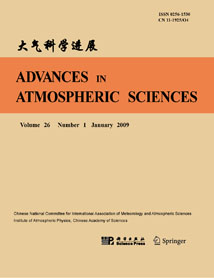| [1] |
KE Zongjian, DONG Wenjie, ZHANG Peiqun,
2008: Multimodel Ensemble Forecasts for Precipitations in China in 1998, ADVANCES IN ATMOSPHERIC SCIENCES, 25, 72-82.
doi: 10.1007/s00376-008-0072-y
|
| [2] |
JIE Weihua, WU Tongwen, WANG Jun, LI Weijing, LIU Xiangwen,
2014: Improvement of 6-15 Day Precipitation Forecasts Using a Time-Lagged Ensemble Method, ADVANCES IN ATMOSPHERIC SCIENCES, 31, 293-304.
doi: 10.1007/s00376-013-3037-8
|
| [3] |
WANG Huijun, FAN Ke, SUN Jianqi, LI Shuanglin, LIN Zhaohui, ZHOU Guangqing, CHEN Lijuan, LANG Xianmei, LI Fang, ZHU Yali, CHEN Hong, ZHENG Fei,
2015: A Review of Seasonal Climate Prediction Research in China, ADVANCES IN ATMOSPHERIC SCIENCES, 32, 149-168.
doi: 10.1007/s00376-014-0016-7
|
| [4] |
Maeng-Ki KIM, Yeon-Hee KIM,
2010: Seasonal Prediction of Monthly Precipitation in China Using Large-Scale Climate Indices, ADVANCES IN ATMOSPHERIC SCIENCES, 27, 47-59.
doi: 10.1007/s00376-009-8014-x
|
| [5] |
Xu Qun,
1995: Analysis of Causes and Seasonal Prediction of the Severe Floods in Yangtze / Huaihe Basins during Summer 1991, ADVANCES IN ATMOSPHERIC SCIENCES, 12, 215-224.
doi: 10.1007/BF02656834
|
| [6] |
LI Fang, LIN Zhongda,
2015: Improving Multi-model Ensemble Probabilistic Prediction of Yangtze River Valley Summer Rainfall, ADVANCES IN ATMOSPHERIC SCIENCES, 32, 497-504.
doi: 10.1007/s00376-014-4073-8
|
| [7] |
LIU Ge, WU Renguang, ZHANG Yuanzhi, and NAN Sulan,
2014: The Summer Snow Cover Anomaly over the Tibetan Plateau and Its Association with Simultaneous Precipitation over the Mei-yu-Baiu region, ADVANCES IN ATMOSPHERIC SCIENCES, 31, 755-764.
doi: 10.1007/s00376-013-3183-z
|
| [8] |
SONG Lianchun, A. J. CANNON, P. H. WHITFIELD,
2007: Changes in Seasonal Patterns of Temperature and Precipitation in China During 1971--2000, ADVANCES IN ATMOSPHERIC SCIENCES, 24, 459-473.
doi: 10.1007/s00376-007-0459-1
|
| [9] |
ZHANG Xinping, LIU Jingmiao, HE Yuanqing, TIAN Lide, YAO Tandong,
2005: Humidity Effect and Its Influence on the Seasonal Distribution of Precipitation δ18O in Monsoon Regions, ADVANCES IN ATMOSPHERIC SCIENCES, 22, 271-277.
doi: 10.1007/BF02918516
|
| [10] |
YUAN Fang, CHEN Wen, ZHOU Wen,
2012: Analysis of the Role Played by Circulation in the Persistent Precipitation over South China in June 2010, ADVANCES IN ATMOSPHERIC SCIENCES, 29, 769-781.
doi: 10.1007/s00376-012-2018-7
|
| [11] |
Liyu Wang, Yunfei FU,
2024: Statistical Analysis of North Pacific Storm Track Precipitation Based on GPM Observation Data, ADVANCES IN ATMOSPHERIC SCIENCES.
doi: 10.1007/s00376-024-4104-z
|
| [12] |
Shuai HU, Tianjun ZHOU, Bo WU, Xiaolong CHEN,
2023: Seasonal Prediction of the Record-Breaking Northward Shift of the Western Pacific Subtropical High in July 2021, ADVANCES IN ATMOSPHERIC SCIENCES, 40, 410-427.
doi: 10.1007/s00376-022-2151-x
|
| [13] |
LIN Zhaohui, WANG Huijun, ZHOU Guangqing, CHEN Hong, LANG Xianmei, ZHAO Yan, ZENG Qingcun,
2004: Recent Advances in Dynamical Extra-Seasonal to Annual Climate Prediction at IAP/CAS, ADVANCES IN ATMOSPHERIC SCIENCES, 21, 456-466.
doi: 10.1007/BF02915572
|
| [14] |
Zhiyi ZHOU, Juan LI, Haishan CHEN, Zhiwei ZHU,
2023: Seasonal Prediction of Extreme High-Temperature Days in Southwestern China Based on the Physical Precursors, ADVANCES IN ATMOSPHERIC SCIENCES, 40, 1212-1224.
doi: 10.1007/s00376-022-2075-5
|
| [15] |
Xiaoran DONG, Yafei NIE, Jinfei WANG, Hao LUO, Yuchun GAO, Yun WANG, Jiping LIU, Dake CHEN, Qinghua YANG,
2024: Deep Learning Shows Promise for Seasonal Prediction of Antarctic Sea Ice in a Rapid Decline Scenario, ADVANCES IN ATMOSPHERIC SCIENCES, 41, 1569-1573.
doi: 10.1007/s00376-024-3380-y
|
| [16] |
Na LI, Lingkun RAN, Linna ZHANG, Shouting GAO,
2017: Potential Deformation and Its Application to the Diagnosis of Heavy Precipitation in Mesoscale Convective Systems, ADVANCES IN ATMOSPHERIC SCIENCES, 34, 894-908.
doi: 10.1007/s00376-017-6282-4
|
| [17] |
Huang Ronghui, Li Xu, Yuan Chongguang, Lu Riyu, Moon Sung-Euii, Kim Ung-Jun,
1998: Seasonal Prediction Experiments of the Summer Droughts and Floods during the Early 1990’s in East Asia with Numerical Models, ADVANCES IN ATMOSPHERIC SCIENCES, 15, 433-446.
doi: 10.1007/s00376-998-0025-5
|
| [18] |
REN Guoyu, DING Yihui, ZHAO Zongci, ZHENG Jingyun, WU Tongwen, TANG Guoli, XU Ying,
2012: Recent Progress in Studies of Climate Change in China, ADVANCES IN ATMOSPHERIC SCIENCES, 29, 958-977.
doi: 10.1007/s00376-012-1200-2
|
| [19] |
Athanassios A. ARGIRIOU, Zhen LI, Vasileios ARMAOS, Anna MAMARA, Yingling SHI, Zhongwei YAN,
2023: Homogenised Monthly and Daily Temperature and Precipitation Time Series in China and Greece since 1960, ADVANCES IN ATMOSPHERIC SCIENCES, 40, 1326-1336.
doi: 10.1007/s00376-022-2246-4
|
| [20] |
GAO Wenhua, SUI Chung-Hsiung,
2013: A Modeling Analysis of Rainfall and Water Cycle by the Cloud-resolving WRF Model over the Western North Pacific, ADVANCES IN ATMOSPHERIC SCIENCES, 30, 1695-1711.
doi: 10.1007/s00376-013-2288-8
|















 AAS Website
AAS Website 
 AAS WeChat
AAS WeChat 
 DownLoad:
DownLoad: